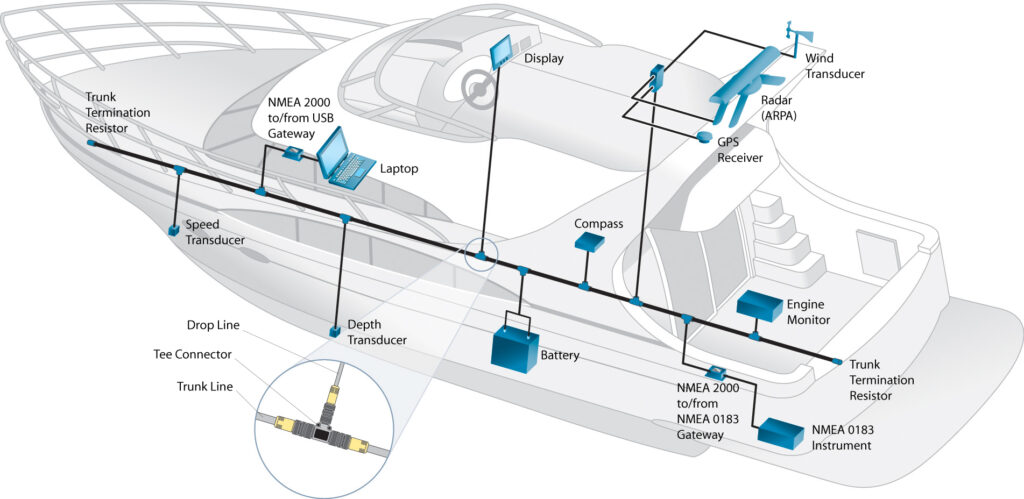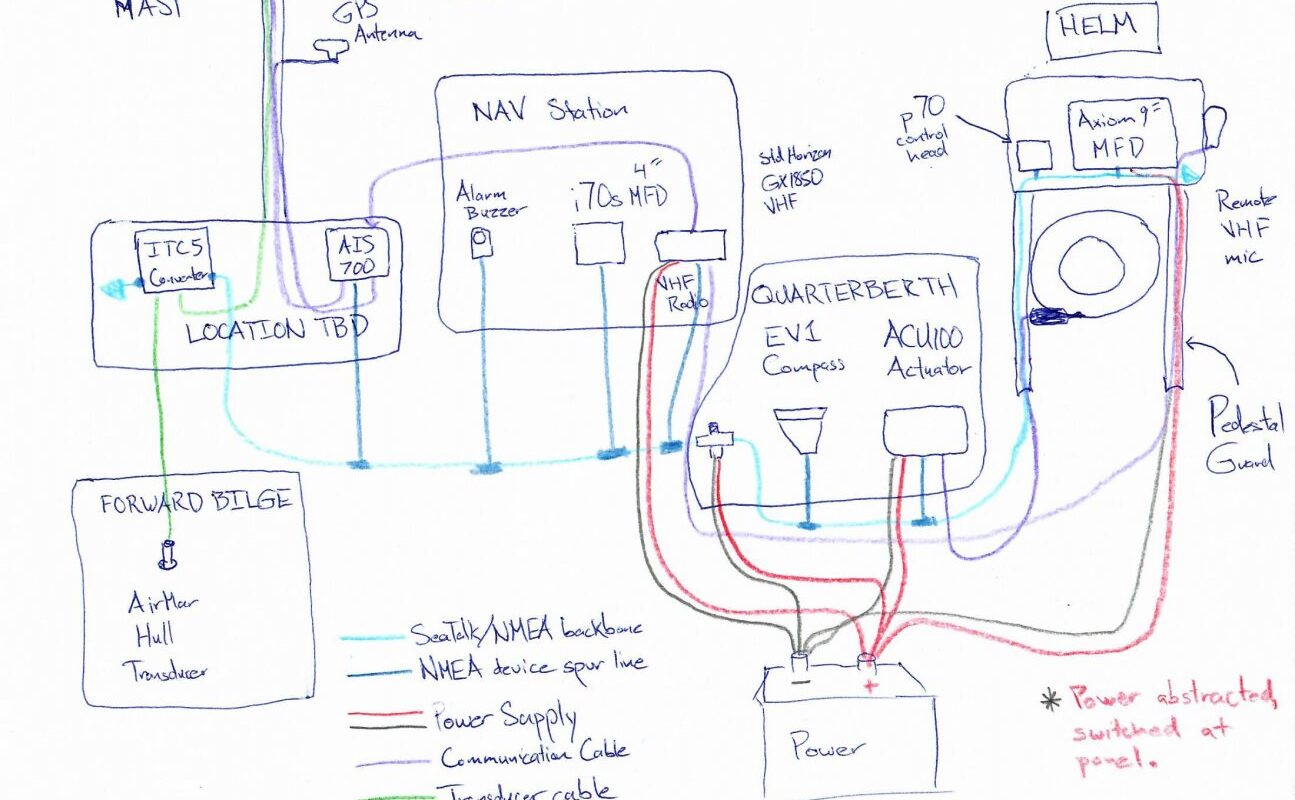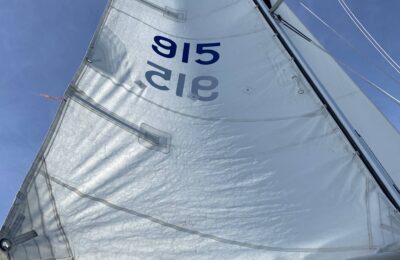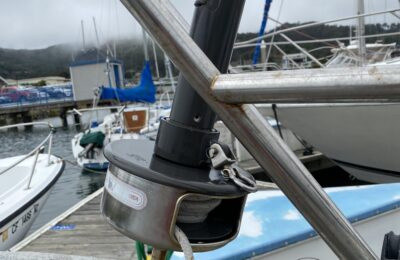“Ko’olea felt the wind across his cheek, the beams of light soaking into the apex of his left shoulder, and saw the fringe of whitewater on the outer reef. The pink men repeated the names of their contraptions: “Chronometer, Compass, Sextant.” He felt pity for these strangely-dressed men who could not pass over the horizon without such contrivances. It would be only two decades before the lives of Ko’olea’s people had been forever changed by the pink men.”
These are all my novice observations/impressions, please feel free to correct and comment. I’m upgrading my electronics to prepare my 1990 Ericson 32-200 for a trip to Hawaii.
Part 1: System Considerations
NMEA2000 Network Design
Having a “network” on a little sailboat sounds like overkill, and it probably is, but this seems to be the best current idea from the makers of navigation and emergency equipment, so it’s where I have pointed my electronics upgrade.
In a non-networked paradigm, a sailboat has a number of separate gadgets/device systems and tools that serve independent purposes. An autopilot receives instructions from a control head in a closed system. A chartplotter has built in maps and can display that location to a sailor, especially well when connected to a GPS. An AIS system can listen for and broadcast to others, positions of the subject craft and its neighbors. Each system requires its own power and provides its own insight to the user. If one breaks, that individual system can be replaced. This paradigm also allows a boat to use systems from entirely different manufacturers and choose the ‘best in class’ from each one. The combination of the information is made in the users brain from a position in the cockpit or below where he/she can observe all of the data.
In an ideal network, all systems would rely on a simplified wiring system with power provided by a network, and with all information shared between devices. (Perhaps in a truly ideal network, there would be no wiring at all, and devices would receive their data and power wirelessly.) There would be no need for spaghetti power wiring for each device. There would be a combination display of data from various sub-systems (AIS, Geo-location, Chart, Fuel consumption, engine well-being, Plotted waypoints for navigation, etc.) One could choose the best device from any manufacturer and all these devices would cooperate with one another in sharing information.
NMEA stands for National Marine Electronics Association and the NMEA2000 standard was developed, I have gathered, to respond to several challenges of the non-networked paradigm I described above. A NMEA2000 network allows:
- Power to be provided to devices on the network via a single connection.
- Straightforward exchange of data between different electronics manufacturers.
- Exchange of data between different types of devices generally (AIS shared to plotter, waypoint shared to autopilot).
- A system example from Wikipedia:

This picture does a good job of illustrating the “trunk/spur” nature of the cable. It isn’t a hub-and-spoke system like your internet router at home. There is one trunk “backbone” line that connects all the devices off of which devices sit, sending and receiving information, and taking power. The trunk must be terminated with resistors at either end in order to function correctly.
A number of limitations still exist:
- The power available on the network is insufficient to satisfy the entire demand for many devices that would be part of the network. (You can’t power your auto-pilot with an itty-bitty network wire). Some devices will still require separate power runs.
- A physical network is still necessary. It would be nice (I mean really, really, really nice) if all of these devices could communicate with one another wirelessly, reliably. They can’t do that. You still have to run a wire to connect everything.
- Despite the idea that devices from one manufacturer need to be able to provide data to other manufacturer over the backbone, there is a provision in the standard which allows manufacturers to have some proprietary connection standards which facilitate connections between their own devices, but require some perhaps complicating steps to get different make devices cooperating.
Industry Adoption
I don’t know very much about this. Here’s a somewhat-recent article describing how people have adopted the standard. Adoption seems recent.
Part 2: Needs Assessment
Sure Shot Case Study
I’ve got needs. Boy, have I got needs.
Need 1: I need the boat to be able to steer itself while I adjust sails, pull in fenders, make burritos.
Response: Raymarine EV100 Wheel Pilot pack.
- EV1 electronic compass sensor core,
- ACU100 actuator “the computer”,
- Pilot drive
- p70 control head – This attaches to the SeatalkNg network
- Pack of SeaTalkNg cables
This package can be implemented on a stand-alone basis, though it is actually using the SeaTalkNg network, which is the Raymarine implementation of NMEA2000
Need 2: I need to know where the GPS satellites think I am, so I can get where I am going without crashing.
Need 3: I need to know where other boats are, and for other boats to know where I am, so we don’t run into one another.
I’m planning to respond to these needs with the Raymarine AIS700, a transceiver system with a GPS antenna, that both receives the locations of others and transmits my location.
Need 4: If I am sleeping, and AIS sees a potential hazard, I need to be awakened. Also, if other sensors detect problematic conditions, (shallow water, substantial deviation in course) I would like to be awakened.
The AIS700 does not, by my reading, contain an internal audible alarm. Alarms are available on the Multi-Function Displays. In addition, Raymarine offers the A80614 alarm buzzer that can be networked and operate based on pre-programmed warnings.
Need 5: I need to know how deep the water is around me, so I don’t run aground. It would be nice to have a record of wind speed I am experiencing, though this is less critical.
In response to this need, Raymarine offers the i70s System Pack:
Here’s a description of that package, with some less-than-perfect audio:
- I70s 4” multifunction display – Connects to SeaTalkNg Network
- ITC-5 Transducer converter – Connects to SeaTalkNg Network
- Raymarine Wind Tranducer – Mounts on the masthead, connects to ITC-5 via wire
- Airmar hull transducer with combined depth/temperature/speed reader in a single cylinder.
- System cables.
None of these parts need power other than that provided via the NMEA SeaTalk network. The i70s can also display AIS target data, which is a valuable consideration.
Need 6: I need to be able to see all of the data I have acquired through the various sub-systems, on the helm, when I need it. I need to be able to see a chart of the waters in which I am sailing, along with depth, AIS target and weather information.
My answer here is the Raymarine Axiom 9” MFD screen. It connects to the SeaTalk network and thus all of the various transducers and appendages.
It can also control the autopilot, though the display’s exclusively touch-screen nature gives me some pause. I don’t want a Tesla-With-I-Pad dash. I’m pretty sure I want buttons for that.
I need to be able to communicate with other boats and people via VHF radio
Raymarine only makes a couple of radios, while other suppliers make many more. My solution here is a Standard Horizon VHF radio that can support a remote mic on the helm. Currently my radio head unit is on the helm, and it is clunky and takes up needless space. Others have pointed out the benefit of a remote mic. The Standard Horizon GX1850 can listen to an NMEA2000 network for GPS and course information. A Standard Horizon remote mic will connect to the head unit and be available on the helm
Other information considerations / needs that I have deemed to be outside the scope of the network implementation for Sure Shot:
If I am on a long passage, out of range of coastal cellular reception, what is the weather/wind going to be like in the next 6/12/24/48 hours?
How can I communicate my position to the “folks-at-home” in a non-emergency situation?
My current plan for satellite communication is to use an Iridium Go. These are satellite gateway routers that in theory permit VOIP (Voice Over Internet Protocol) telephony as well as data exchange. Many reviews say the VOIP phone calls are unreliable. It would be the equivalent of a sat-phone used as a modem. A number of weather services allow the downloading of weather information via the Iridium Go.
I need to know if my engine is in danger of failing.
The NMEA2000 systems offer a variety of responses for this need, especially tailored towards power-boaters. One can imagine how elegant (and bloodless) it would be for a fancy power yacht to set a half-dozen waypoints from Vancouver BC to San Diego, press go, and then let the boat drive itself down the coast. The user would only need to know he had enough fuel and that his big motor wouldn’t die.
I think if I looked hard enough, I could find a wiring rig gateway thing that would let me pull information about my three-cylinder Yanmar onto my network, and maybe I could set a trigger to wake me up if the exhaust temperature exceeded a specified amount, etc.. I don’t think the value above and beyond my current system of looking at, listening to, and smelling the engine, outweighs the amount of extra baloney that would be involved in trying to get this information to my network.
I need to know if I am going to run into something in the fog.
Some people put radar sensors on their boats. If I had plans to explore poorly charted coasts, or operate frequently in sea-ways with lots of fog, maybe I would install a radar. As it stands, I think if it is so foggy that I need to rely on radar to be safe, I shouldn’t be out. There’s always the chance that I head out in bright sunshine and blue skies, and get caught out in the fog, but hopefully AIS and prudent speeds would help me limp back home with some care.
One choice I have made is to keep (nearly) everything Raymarine. This has essentially a function of wanting to use the EV100 wheel pilot which seems like the most widely-used wheel pilot system, and a desire to avoid any conflicts between manufacturers. In this sense I am not taking advantage of some of the proposed benefits of the NMEA2000 architecture, but what I want is a plug-and-play system I can install myself without spending a month back-and-forth with various customer service departments. Jury is still out on whether I will achieve
Part 3: Implementation/Installation Plan
Since I am purposefully creating a Raymarine/NMEA2000 world for myself, it might seem like Raymarine would help to illuminate the design process. They are some help, and it is especially useful to find an on-line color version to see the blue backbone path and the black-and-white spur lines.
I have added several component to the above system (which combines an EV100 pilot pack and i70s transducer pack). My planned system looks like this:
I am replacing my pedestal guard and instrument housing as part of the project as well. Based on feedback I received in the EricsonYachts.org forum, I have selected:
Angle Guard, 1.25” diameter tubes – NavPod AG118
Instrument Housing – Navpod GP1040-16
Guard Feet – Edson 310ST-100-125
Edson Top Plate – Edson 1625ST45
I want the 1.25” diameter rail for running cables up and down. Several people suggested custom Railmakers guards, but I don’t think I could beat off-the-shelf pricing and the same manufacturer as the plastic pod. Custom stuff also involves gasoline and time to procure.
The drawing describes the other locations. A cluster of gadgets will go in my double quarterberth, another cluster near my “nav station” (rather compact on the 32-200) and some positioning remains to be determined.
Below, I will have the little i70s screen and the buzzer. I thought at one point it would make sense to have the Axiom big MFD screen below. But really the primary use case for the screen will be the chart-plotter, and if I’m driving, I’ll be doing that from the helm, not pushing buttons below decks.
The nav station on a 32-200 is a narrow space with a lift-up writing surface, below which sits a large cooler. This is nice for small kegs of beer, but leaves little room for surface-mounted electronics. I’ll be contriving or utilizing some other mounting surfaces nearby.
What’s daunting for me at this point is not the purchase or the design. The tough part is going to be how to get everything installed properly without tearing my boat apart to chase wires.



